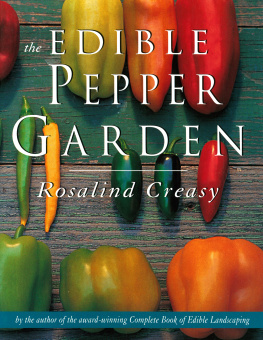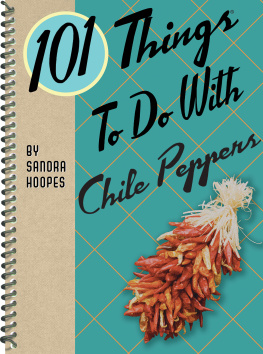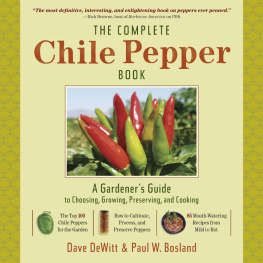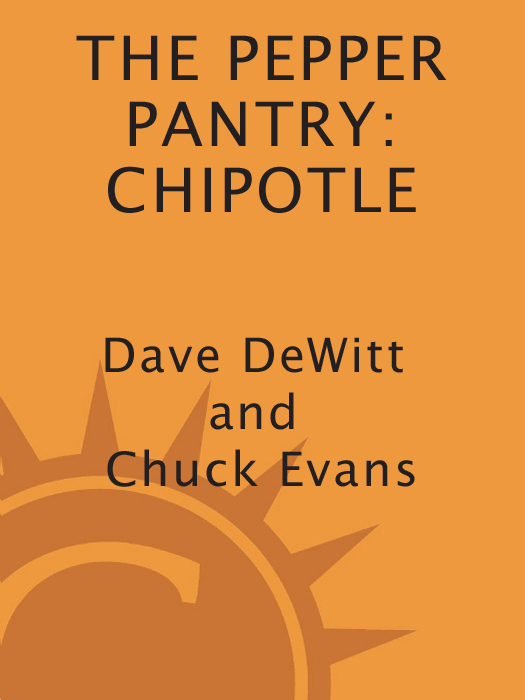Copyright 1997 by Dave DeWitt and Chuck Evans
All rights reserved. No part of this book may be reproduced in any form, except brief excerpts for the purpose of review, without written permission from the publisher.

Celestial Arts
an imprint of Ten Speed Press
Post Office Box 7123
Berkeley, California 94707
www.tenspeed.com
Distributed in Australia by Simon & Schuster Australia, in Canada by Ten Speed Press Canada, in New Zealand by Southern Publishers Group, in South Africa by Real books, and in the United Kingdom and Europe by Publishers Group UK.
Library of Congress Cataloging-in-Publication Data:
DeWitt, Dave
The pepper pantry. Chipotles / by Dave DeWitt and Chuck Evans
p. cm.
eISBN: 978-0-307-82436-3
1. Cookery (Hot peppers) 2. Hot peppers. I. Evans, Chuck.
II. Title
TX803.P46D488 1997
641.6384dc20
96-30488
v3.1
CONTENTS
INTRODUCTION
B oth of us got acquainted with chipotle chiles during our frequent visits to Mexico. After all those years of tasting Mexican chiles, the chipotle still stands out because of its unique combination of smokiness and heat. Chuck became so enamored of the chipotle that he designed several chipotle sauces for his company, Sauces and Salsas, Ltd. His Montezuma brand of smokey chipotle hot sauces and salsas is one of only two products to have trademarks of variety names of chiles; the other, of course, is Tabasco Sauce.
As we point out, chipotle is a generic term for any smoked chile and usually means the smoked red jalapeo. However, there are other varieties of smoked chiles available, ranging from the diminutive coban to the long pasilla oaxaqueo to the blistering smoked habanero. For adventurous chileheads, we have included instructions for smoking your own chipotles. Simply put, the recipes are our personal favorites of the dozens and dozens that weve tasted over the years. We offer quite a few sauces because that is the most common use for chipotles in both Mexico and the rest of North America. The chipotle sauces are used in cooking or as a condiment, just like any other sauce or salsa. Sauces are a great way to intensify the smoky chipotle experience.
The only other book on chipotles that were aware of is Chipotle Chile Cookbook (The Olive Press) by our friend Jackie McMahan, and we recommend it highly.
THE SMOKY CHILES
Nomenclature
G enerally speaking, in English chipotle refers to any smoked chile pepper. The Spanish word chipotle is a contraction of chilpotle in the Nhuatl language of the Aztecs, where chil referred to the hot pepper and potle was derived from poctli, meaning smoked. The word was apparently reversed from Nhuatl, where it originally was spelled pochilli. Other early spellings in Mexico are tzilpoctil, tzonchilli, and texochilli.
The most commonly smoked chiles are jalapeos, named for the city of Jalapa in the state of Veracruz. They are also known in Mexico as cuaresmeos, or Lenten chiles. In Puebla, Central Mexico, and Oaxaca, jalapeos are known as huachinangos, while in coastal Mexico and Veracruz they are called chiles gordos.
Origins
Smoked chiles had their origin in the ancient civilization of Teotihuacan, north of present-day Mexico City. It was the largest city/state in Mesoamerica, and flourished centuries before the rise of the Aztecs. Chipotles also made an appearance in the marketplaces of Tenochtitln, the capital city of the Aztecs that is now called Mexico City. Certain varieties of fleshy chiles, now called jalapeos, would not dry properly in the suntheir thick flesh would rot first. However, like meats, they could be preserved by the process known as smoke-drying.
History
Bernardino de Sahagn, a Spanish friar who lived in Mexico in the early 1500s, described a dish called teatzin, which was served in Cholula in the state of Puebla. It contained a combination of chipotle and pasilla sauces for stewing fresh jalapeos and lenten palm flowers.
In 1575, a Spanish visitor to Mexico, Juan de la Cueva, described a dish that combined the seedless chipotles (capones), onions, pine nuts, and a broth with meat juice and pulque (agave beer). The sauce was simmered with chunks of meat to create pipin de pion.
For hundreds of years after the Aztecs, smoked chiles were found predominantly in the markets of Central and South Mexico, such as Puebla, Oaxaca, Veracruz, and Chiapas. In Huatasco in the state of Veracruz, a salsa made with tomatoes, peanuts, and chipotles has been made for centuries. It is called tlatonile ().
Varieties
The true chipotle is tan to brown, leathery, and is often described as looking like a cigar butt. It is deeply imbued with smoke and is both hot and flavorful. This main variety is also called chile ahumado (smoked chile); chile meco (blackish-red chile; meco is close to seco, meaning dry); the double terms chipotle meco and chipotle tpico, and just tpico. Further confusing the issue is a cultivated variety of jalapeo that is also named Tpico. Yes, the Tipico variety is often smoked to become a tpico chipotle.
Other varieties of smoked jalapeos are often mistaken for the tpico chipotle. The most common one is called morita, which means little blackberry in Spanish. The color of this smoked chile is dark red, sometimes approaching purple in color. Often the morita is referred to as a smoked serrano chile, but this is inaccurate. Both the tpico and the morita are smoked jalapeos; the difference is that the morita is not smoked nearly as long, and thus it remains very leathery and pliable. Not only is the smoky flavor much more intense in the tpico, its flavor is much richer.
But the morita is commonly marketed as the tpico chipotle because it can bring two to four dollars more per pound with that name. Unfortunately, most of the chipotles being sold in markets in the United States are in actuality the inferior moritas. This is because most of chipotles produced in Mexico are eaten there, leaving little for export.
To make up for lack of the tpico variety to export, producers in the northern states of Mexico, particularly Chihuahua, have turned to the moritas, which are much less expensive to produce. Unfortunately, they call the moritas chipotles and sometimes claim that they have never heard of the tpico variety. To further confuse the issue, in the interior the tpico is known by brokers as Veracruz.
Other varieties of smoked chiles include:
Cobn: a piqun chile that is smoked in southern Mexico and Guatemala.
Pasilla de Oaxaca: a variety of pasilla chile that is smoked in Oaxaca and is used in the famous mole negro.
Jalapeo chico: jalapeos that are smoked while theyre still green. Usually, they are culls from the fresh market that need to be preserved.
Capones: This rare smoked chile is a red jalapeo without seeds; the term means castrated ones. They are quite expensive and are rarely exported.
Habanero: A smoked habanero product has been introduced as a very hot substitute for chipotles.











